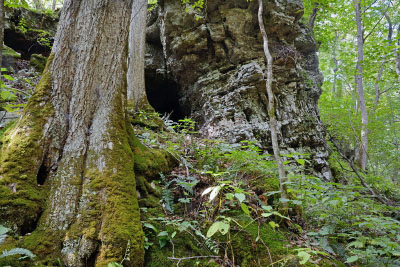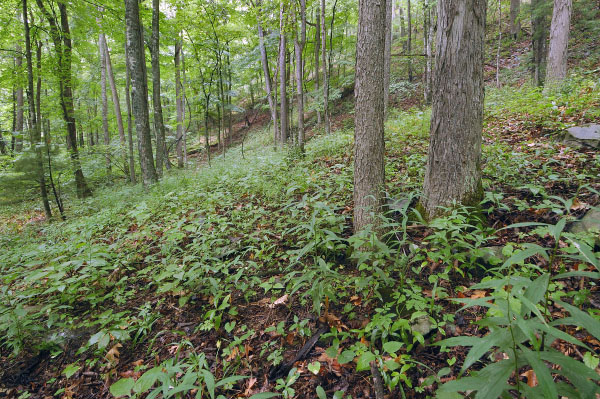
 Sở Bảo Tồn và Giải Trí
Sở Bảo Tồn và Giải Trí Bảo Tồn. Bảo Vệ. Tận Hưởng.
 Sở Bảo Tồn và Giải Trí
Sở Bảo Tồn và Giải Trí  Mục lục
Mục lụcRừng đá vôi khô và khô ẩm vùng núi
Nhóm này chủ yếu bao gồm các khu rừng hỗn giao gỗ cứng trên núi với thành phần đáng kể là cây sồi và xuất hiện trên đá vôi, đá dolomit, và ít phổ biến hơn là đá phiến sét, đá phiến sét và đá sa thạch có nhiều canxi. Các cộng đồng trong nhóm này sinh sống trên các sườn dốc và đỉnh đồi cận nhiệt đới đến khá khô hạn với nhiều khía cạnh khác nhau và đất đai màu mỡ. Các loại cộng đồng được phân loại tách biệt theo các mức độ giao nhau của địa lý, độ ẩm đất, độ sâu đất và hướng đất, và được chia thành nhóm "khô" và nhóm "khô ẩm".
Dry calcareous forests occur on subxeric to xeric, fertile habitats over carbonate formations of limestone and dolostone, or very rarely highly calcareous siltstone or shale. Habitats are steep, usually rocky, south- to west-facing slopes at elevations from < 300 to 900 m (< 1,000 to 2,900 ft). Soils vary from circumneutral to moderately alkaline and have high calcium levels. Confined in Virginia to the mountains, these communities are most frequent and extensive in the Ridge and Valley, but occur locally in both the Blue Ridge and Cumberland Mountains. Tree canopies vary from nearly closed to quite open and woodland-like. Overstory mixtures of chinquapin oak (Quercus muehlenbergii), sugar maple (Acer saccharum), black maple (Acer nigrum), northern red oak (Quercus rubra), white oak (Quercus alba), Shumard oak (Quercus shumardii), white ash (Fraxinus americana) and blue ash (Fraxinus quadrangulata, extreme southwest Virginia only) are typical. These forests and woodlands share many understory and herbaceous plants with the Piedmont / Mountain Basic Woodlands group and are similarly species-rich. A few of the taxa that are confined to or most important in the limestone and dolostone communities include Carolina buckthorn (Frangula caroliniana), round-leaved ragwort (Packera obovata), robin's-plantain (Erigeron pulchellus var. pulchellus), American beakgrain (Diarrhena americana), slender muhly (Muhlenbergia tenuiflora), black-seed ricegrass (Patis racemosa), limestone purple sedge (Carex purpurifera, in extreme southwestern Virginia only), hairy sunflower (Helianthus hirsutus), small-headed sunflower (Helianthus microcephalus), northern leatherflower (Clematis viorna), and white death-camas (Anticlea glauca). Logging and fire exclusion are probably the biggest threats to dry calcareous forests.

Dry-mesic calcareous forests occur in deeper soils of valley sideslopes, lower mountain slopes, gentle crests, and ravines up to about 1,150 m (3,800 ft) elevation. Forests of this group are widely distributed in the Ridge and Valley province, more local in the Cumberland Mountains, and rare in the northern Piedmont Triassic Basin. Mixtures of sugar maple (Acer saccharum), black maple (Acer nigrum) , chinquapin oak (Quercus muehlenbergii), white oak (Quercus alba), northern red oak (Quercus rubra), black oak (Quercus velutina), white ash (Fraxinus americana), and hickories (Carya spp.) are typical. A distinctive variant is co-dominated by eastern white-cedar (Thuja occidentalis), usually in association with eastern white pine (Pinus strobus), eastern hemlock (Tsuga canadensis), and hardwoods. Tulip-tree (Liriodendron tulipifera) is most abundant as an invader of logged stands. Understory and herbaceous vegetation varies from sparse to lush (especially on limestone sites), but is generally dominated by species characteristic of submesic soil moisture conditions, such as white snakeroot (Ageratina altissima var. altissima), hog-peanut (Amphicarpaea bracteata), common eastern bromegrass (Bromus pubescens), sharp-lobed hepatica (Hepatica acutiloba), and common black cohosh (Actaea racemosa).
Rừng đá vôi khô ẩm dễ phân biệt với Rừng dốc và Vịnh giàu hoặc Rừng ẩm cơ bản do chúng xuất hiện ở những địa điểm ít được bảo vệ hơn và không có các loài thực vật ưa ẩm nổi bật như cây rễ xanh (Caulophyllum thalictroides), cây lá rộng ưa nước (Hydrophyllum canadense) hoặc cây tầm ma (Laportea canadensis). Nhiều khu rừng đá vôi khô cằn đã bị chặt phá hoặc phá hủy để phục vụ cho mục đích nông nghiệp. Trong một số trường hợp, có vẻ như các đám cây này là kết quả của sự xâm lấn của các loài cây ưa ẩm hơn (đặc biệt là cây thích đường) vào rừng sồi-hickory, có thể là do cháy rừng kéo dài. Tần bì trắng, một loại cây cộng sinh rất phổ biến ở cả rừng đá vôi khô và khô ẩm, hiện đang phải chịu tỷ lệ tử vong đáng kể do sự bùng phát của loài bọ cánh cứng đục thân cây tần bì.
Tài liệu tham khảo: Fleming (1999), Fleming và Coulling (2001), Fleming và Moorhead (1996), Fleming và Moorhead (2000), Rawinski et al. (1996).Nhấp vào đây để xem thêm ảnh về nhóm cộng đồng sinh thái này.
 © DCR-DNH, Gary P. Fleming.
© DCR-DNH, Gary P. Fleming.
Bảy loại cộng đồng được hỗ trợ bởi 102 mẫu lô định lượng (Hình 1 ). Phân loại của hầu hết các đơn vị khá chặt chẽ, nhưng sự phân bố và tình trạng đầy đủ của ba loại chỉ được biết đến ở Dãy núi Cumberland và Sườn núi và Thung lũng phía Nam vẫn chưa rõ ràng và cần có thêm thông tin. Nhấp vào bất kỳ mã CEGL nào được tô sáng bên dưới để xem mô tả USNVC toàn cầu do NatureServe Explorer cung cấp.

 Tải xuống bảng tính thống kê tóm tắt thành phần cho từng loại cộng đồng được liệt kê bên dưới.
Tải xuống bảng tính thống kê tóm tắt thành phần cho từng loại cộng đồng được liệt kê bên dưới.

